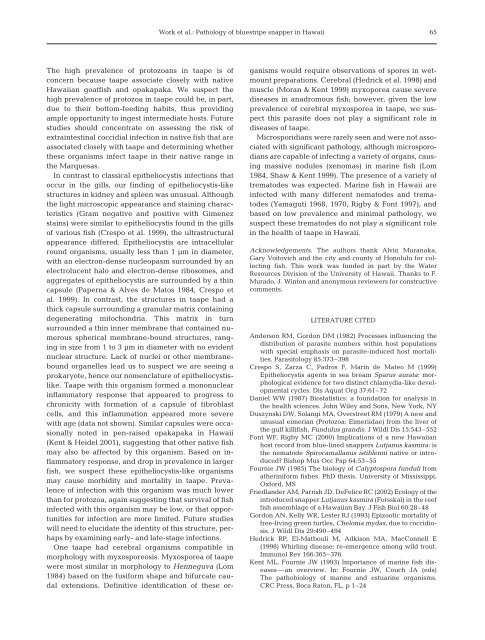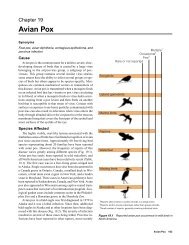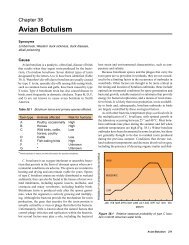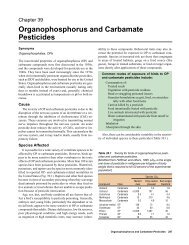Protozoal and epitheliocystis-like infections in the introduced
Protozoal and epitheliocystis-like infections in the introduced
Protozoal and epitheliocystis-like infections in the introduced
Create successful ePaper yourself
Turn your PDF publications into a flip-book with our unique Google optimized e-Paper software.
Work et al.: Pathology of bluestripe snapper <strong>in</strong> Hawaii<br />
65<br />
The high prevalence of protozoans <strong>in</strong> taape is of<br />
concern because taape associate closely with native<br />
Hawaiian goatfish <strong>and</strong> opakapaka. We suspect <strong>the</strong><br />
high prevalence of protozoa <strong>in</strong> taape could be, <strong>in</strong> part,<br />
due to <strong>the</strong>ir bottom-feed<strong>in</strong>g habits, thus provid<strong>in</strong>g<br />
ample opportunity to <strong>in</strong>gest <strong>in</strong>termediate hosts. Future<br />
studies should concentrate on assess<strong>in</strong>g <strong>the</strong> risk of<br />
extra<strong>in</strong>test<strong>in</strong>al coccidial <strong>in</strong>fection <strong>in</strong> native fish that are<br />
associated closely with taape <strong>and</strong> determ<strong>in</strong><strong>in</strong>g whe<strong>the</strong>r<br />
<strong>the</strong>se organisms <strong>in</strong>fect taape <strong>in</strong> <strong>the</strong>ir native range <strong>in</strong><br />
<strong>the</strong> Marquesas.<br />
In contrast to classical <strong>epi<strong>the</strong>liocystis</strong> <strong><strong>in</strong>fections</strong> that<br />
occur <strong>in</strong> <strong>the</strong> gills, our f<strong>in</strong>d<strong>in</strong>g of <strong>epi<strong>the</strong>liocystis</strong>-<strong>like</strong><br />
structures <strong>in</strong> kidney <strong>and</strong> spleen was unusual. Although<br />
<strong>the</strong> light microscopic appearance <strong>and</strong> sta<strong>in</strong><strong>in</strong>g characteristics<br />
(Gram negative <strong>and</strong> positive with Gimenez<br />
sta<strong>in</strong>s) were similar to <strong>epi<strong>the</strong>liocystis</strong> found <strong>in</strong> <strong>the</strong> gills<br />
of various fish (Crespo et al. 1999), <strong>the</strong> ultrastructural<br />
appearance differed. Epi<strong>the</strong>liocystis are <strong>in</strong>tracellular<br />
round organisms, usually less than 1 µm <strong>in</strong> diameter,<br />
with an electron-dense nucleopasm surrounded by an<br />
electrolucent halo <strong>and</strong> electron-dense ribosomes, <strong>and</strong><br />
aggregates of <strong>epi<strong>the</strong>liocystis</strong> are surrounded by a th<strong>in</strong><br />
capsule (Paperna & Alves de Matos 1984, Crespo et<br />
al. 1999). In contrast, <strong>the</strong> structures <strong>in</strong> taape had a<br />
thick capsule surround<strong>in</strong>g a granular matrix conta<strong>in</strong><strong>in</strong>g<br />
degenerat<strong>in</strong>g mitochondria. This matrix <strong>in</strong> turn<br />
surrounded a th<strong>in</strong> <strong>in</strong>ner membrane that conta<strong>in</strong>ed numerous<br />
spherical membrane-bound structures, rang<strong>in</strong>g<br />
<strong>in</strong> size from 1 to 3 µm <strong>in</strong> diameter with no evident<br />
nuclear structure. Lack of nuclei or o<strong>the</strong>r membranebound<br />
organelles lead us to suspect we are see<strong>in</strong>g a<br />
prokaryote, hence our nomenclature of <strong>epi<strong>the</strong>liocystis</strong><strong>like</strong>.<br />
Taape with this organism formed a mononuclear<br />
<strong>in</strong>flammatory response that appeared to progress to<br />
chronicity with formation of a capsule of fibroblast<br />
cells, <strong>and</strong> this <strong>in</strong>flammation appeared more severe<br />
with age (data not shown). Similar capsules were occasionally<br />
noted <strong>in</strong> pen-raised opakapaka <strong>in</strong> Hawaii<br />
(Kent & Heidel 2001), suggest<strong>in</strong>g that o<strong>the</strong>r native fish<br />
may also be affected by this organism. Based on <strong>in</strong>flammatory<br />
response, <strong>and</strong> drop <strong>in</strong> prevalence <strong>in</strong> larger<br />
fish, we suspect <strong>the</strong>se <strong>epi<strong>the</strong>liocystis</strong>-<strong>like</strong> organisms<br />
may cause morbidity <strong>and</strong> mortality <strong>in</strong> taape. Prevalence<br />
of <strong>in</strong>fection with this organism was much lower<br />
than for protozoa, aga<strong>in</strong> suggest<strong>in</strong>g that survival of fish<br />
<strong>in</strong>fected with this organism may be low, or that opportunities<br />
for <strong>in</strong>fection are more limited. Future studies<br />
will need to elucidate <strong>the</strong> identity of this structure, perhaps<br />
by exam<strong>in</strong><strong>in</strong>g early- <strong>and</strong> late-stage <strong><strong>in</strong>fections</strong>.<br />
One taape had cerebral organisms compatible <strong>in</strong><br />
morphology with myxosporeosis. Myxosporea of taape<br />
were most similar <strong>in</strong> morphology to Henneguva (Lom<br />
1984) based on <strong>the</strong> fusiform shape <strong>and</strong> bifurcate caudal<br />
extensions. Def<strong>in</strong>itive identification of <strong>the</strong>se organisms<br />
would require observations of spores <strong>in</strong> wetmount<br />
preparations. Cerebral (Hedrick et al. 1998) <strong>and</strong><br />
muscle (Moran & Kent 1999) myxoporea cause severe<br />
diseases <strong>in</strong> anadromous fish; however, given <strong>the</strong> low<br />
prevalence of cerebral myxosporea <strong>in</strong> taape, we suspect<br />
this parasite does not play a significant role <strong>in</strong><br />
diseases of taape.<br />
Microsporidians were rarely seen <strong>and</strong> were not associated<br />
with significant pathology, although microsporodians<br />
are capable of <strong>in</strong>fect<strong>in</strong>g a variety of organs, caus<strong>in</strong>g<br />
massive nodules (xenomas) <strong>in</strong> mar<strong>in</strong>e fish (Lom<br />
1984, Shaw & Kent 1999). The presence of a variety of<br />
trematodes was expected. Mar<strong>in</strong>e fish <strong>in</strong> Hawaii are<br />
<strong>in</strong>fected with many different nematodes <strong>and</strong> trematodes<br />
(Yamaguti 1968, 1970, Rigby & Font 1997), <strong>and</strong><br />
based on low prevalence <strong>and</strong> m<strong>in</strong>imal pathology, we<br />
suspect <strong>the</strong>se trematodes do not play a significant role<br />
<strong>in</strong> <strong>the</strong> health of taape <strong>in</strong> Hawaii.<br />
Acknowledgements. The authors thank Alv<strong>in</strong> Muranaka,<br />
Gary Voitovich <strong>and</strong> <strong>the</strong> city <strong>and</strong> county of Honolulu for collect<strong>in</strong>g<br />
fish. This work was funded <strong>in</strong> part by <strong>the</strong> Water<br />
Resources Division of <strong>the</strong> University of Hawaii. Thanks to F.<br />
Murado, J. W<strong>in</strong>ton <strong>and</strong> anonymous reviewers for constructive<br />
comments.<br />
LITERATURE CITED<br />
Anderson RM, Gordon DM (1982) Processes <strong>in</strong>fluenc<strong>in</strong>g <strong>the</strong><br />
distribution of parasite numbers with<strong>in</strong> host populations<br />
with special emphasis on parasite-<strong>in</strong>duced host mortalities.<br />
Parasitology 85:373–398<br />
Crespo S, Zarza C, Padros F, Mar<strong>in</strong> de Mateo M (1999)<br />
Epi<strong>the</strong>liocystis agents <strong>in</strong> sea bream Sparus aurata: morphological<br />
evidence for two dist<strong>in</strong>ct chlamydia-<strong>like</strong> developmental<br />
cycles. Dis Aquat Org 37:61–72<br />
Daniel WW (1987) Biostatistics: a foundation for analysis <strong>in</strong><br />
<strong>the</strong> health sciences. John Wiley <strong>and</strong> Sons, New York, NY<br />
Duszynski DW, Solangi MA, Overstreet RM (1979) A new <strong>and</strong><br />
unusual eimerian (Protozoa: Eimeriidae) from <strong>the</strong> liver of<br />
<strong>the</strong> gulf killifish, Fundulus gr<strong>and</strong>is. J Wildl Dis 15:543–552<br />
Font WF, Rigby MC (2000) Implications of a new Hawaiian<br />
host record from blue-l<strong>in</strong>ed snappers Lutjanus kasmira: is<br />
<strong>the</strong> nematode Spirocamallanus istiblenni native or <strong>in</strong>troduced?<br />
Bishop Mus Occ Pap 64:53–55<br />
Fournie JW (1985) The biology of Calyptospora funduli from<br />
a<strong>the</strong>r<strong>in</strong>iform fishes. PhD <strong>the</strong>sis. University of Mississippi,<br />
Oxford, MS<br />
Friedl<strong>and</strong>er AM, Parrish JD, DeFelice RC (2002) Ecology of <strong>the</strong><br />
<strong>in</strong>troduced snapper Lutjanus kasmira (Forsskal) <strong>in</strong> <strong>the</strong> reef<br />
fish assemblage of a Hawaiian Bay. J Fish Biol 60:28–48<br />
Gordon AN, Kelly WR, Lester RJ (1993) Epizootic mortality of<br />
free-liv<strong>in</strong>g green turtles, Chelonia mydas, due to coccidiosis.<br />
J Wildl Dis 29:490–494<br />
Hedrick RP, El-Matbouli M, Adkison MA, MacConnell E<br />
(1998) Whirl<strong>in</strong>g disease: re-emergence among wild trout.<br />
Immunol Rev 166:365–376<br />
Kent ML, Fournie JW (1993) Importance of mar<strong>in</strong>e fish diseases—an<br />
overview. In: Fournie JW, Couch JA (eds)<br />
The pathobiology of mar<strong>in</strong>e <strong>and</strong> estuar<strong>in</strong>e organisms.<br />
CRC Press, Boca Raton, FL, p 1–24
















